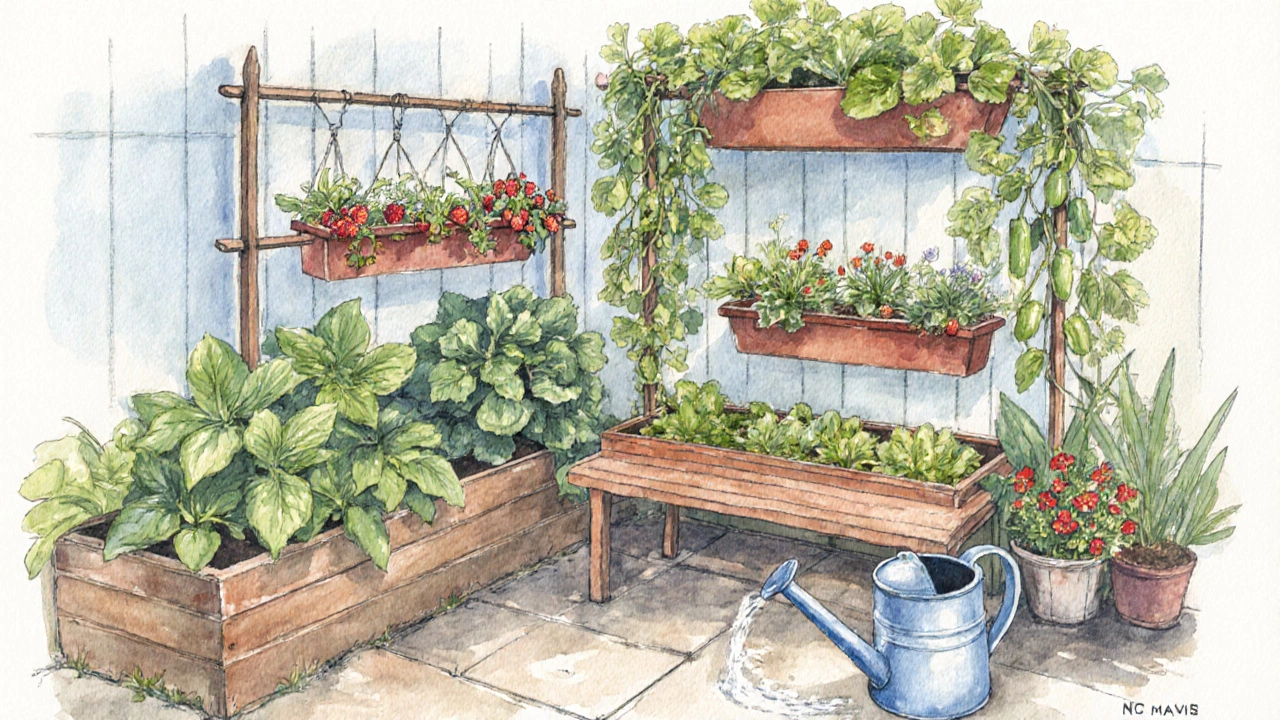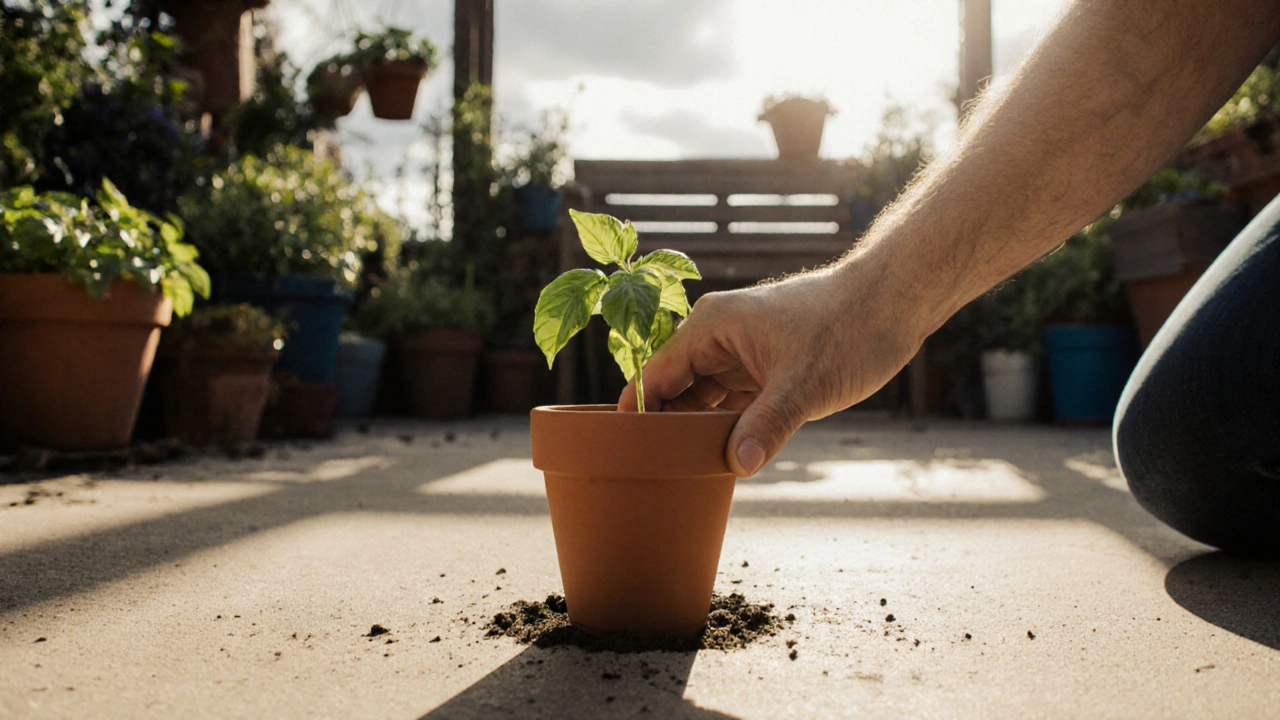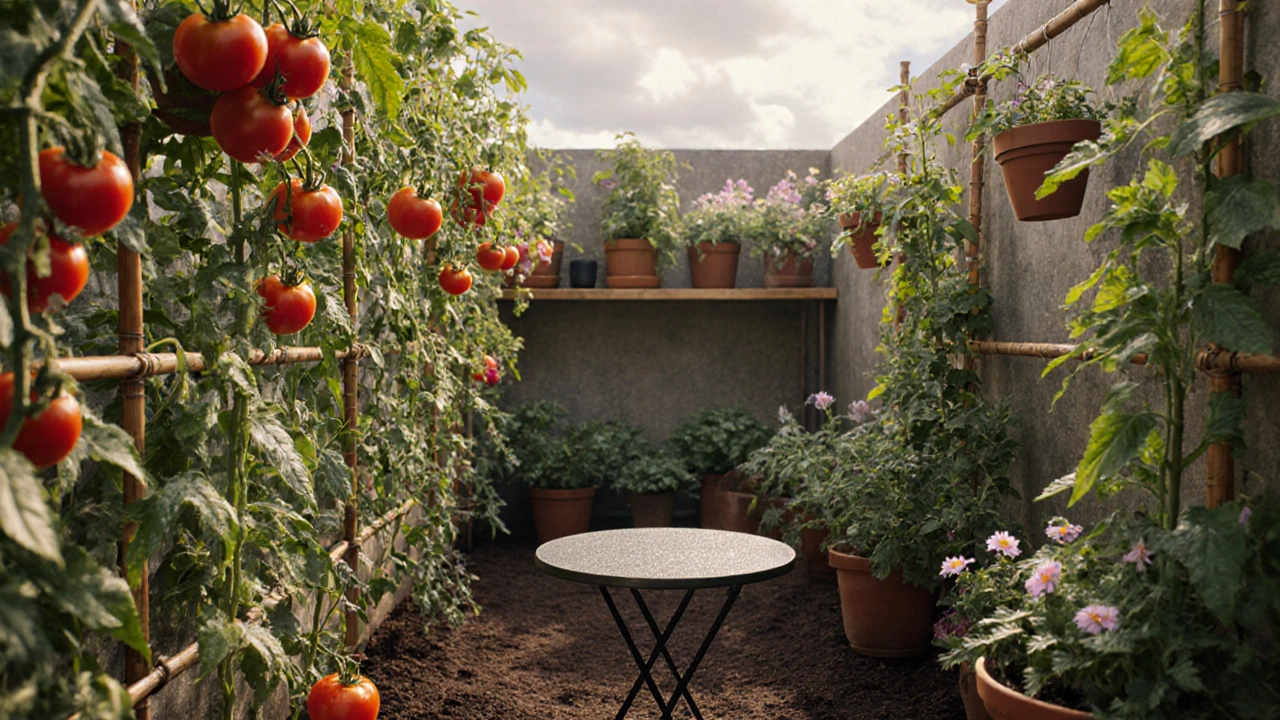Is a 10x10 patio big enough? If you’re staring at a small outdoor space in Manchester and wondering if it’s worth the effort to turn it into a garden, the answer is yes - but only if you plan it right. A 10x10 patio gives you 100 square feet of usable space. That’s not huge, but it’s more than enough to grow fresh herbs, leafy greens, flowers, and even a few small fruiting plants. The real question isn’t about size - it’s about how you use it.
What can you actually grow on a 10x10 patio?
You’d be surprised what fits in 100 square feet when you think vertically and smartly. A single tomato plant needs about 2 square feet of ground space, but if you grow it in a tall pot and train it up a trellis, you free up floor space for other plants. Same with cucumbers, beans, and even small pepper varieties. In a well-designed 10x10 layout, you can easily fit:
- 4-6 large containers for tomatoes, peppers, or eggplants
- 10-15 herb pots (basil, thyme, mint, rosemary)
- 2-3 vertical planters for strawberries or lettuces
- 3-4 compact flower beds or hanging baskets for color
- One small seating area - even just a bench or two chairs
People think they need a yard to grow food. But in cities like Manchester, where outdoor space is limited, the most successful gardeners work with what they have. A 10x10 patio can produce enough herbs to season your meals all summer and enough lettuce to make daily salads. It won’t feed a family year-round, but it’ll cut your grocery bill and make your meals taste better.
Why most people fail with small patios
The biggest mistake? Treating it like a lawn. People buy a few big pots, fill them with soil, and leave the rest empty. That’s a waste. A 10x10 patio isn’t meant for open space - it’s meant for layers. Think of it like a three-tiered cake: ground level, mid-height, and overhead.
Ground level: Use pots, raised beds, or even repurposed wooden crates. Don’t let the floor sit bare. Even a few inches of soil under a pot can be used for creeping thyme or chamomile.
Mid-height: Install wall planters, hanging baskets, or stackable planter towers. These take up almost no floor space but give you extra growing room. A single vertical planter can hold 12 plants in the space of one pot.
Overhead: Use trellises, pergolas, or even tension wires to grow climbing plants. Passionfruit, cucumbers, and nasturtiums will drape beautifully over the edges of your patio, giving you shade and privacy.
People also forget about light. In Manchester, sun doesn’t always hit the ground evenly. A 10x10 patio might get four hours of direct sun - enough for most vegetables, but only if you place sun-lovers (tomatoes, peppers) where the light hits hardest, and shade-tolerant plants (lettuce, spinach, mint) where it’s cooler.
Layout ideas that work
Here’s one simple, proven layout for a 10x10 patio:
- Place a 4x2-foot raised bed along the back wall - perfect for tomatoes and basil.
- Line the right side with three 18-inch pots: one for strawberries, one for chives, one for oregano.
- Hang two baskets from the ceiling or railing: one with trailing lobelia, one with cherry tomatoes.
- Put a narrow 2x6-foot shelf on the left wall for smaller herbs and seedlings.
- Leave the center open for a small bistro set or a single chair and side table.
This setup uses every inch. It’s not flashy, but it’s functional. You get 20+ edible plants, three types of flowers, and a place to sit with your morning coffee. And because everything’s close together, watering and harvesting take less than 10 minutes a day.

What doesn’t fit - and why
Don’t try to grow a full-sized apple tree. Or a watermelon. Or a 6-foot sunflower. These plants need room to spread, deep soil, and lots of sun. They’ll crowd out everything else and still won’t fruit well in a container. Stick to dwarf or compact varieties.
Also, avoid bulky furniture. A large outdoor sofa might look nice in a catalog, but it eats up 30 square feet of growing space. A foldable bistro set or a wooden bench with storage underneath is smarter. You can tuck it away when you need to rearrange plants.
And don’t overwater. Small patios dry out faster, but they also drain poorly if the surface isn’t sloped. Use pots with drainage holes. Never let water pool under containers. Root rot kills more patio gardens than lack of sun.
Seasonal tips for Manchester weather
Manchester isn’t known for long, hot summers. But that doesn’t mean you can’t garden here. You just need to work with the seasons.
April-May: Start with cool-season crops - lettuce, spinach, radishes, peas. These grow fast and can handle light frost. Use cloches or row covers if nights are still chilly.
June-August: Switch to heat-lovers - tomatoes, peppers, basil, marigolds. Keep them well-watered. Mulch with straw or shredded leaves to hold moisture.
September-October: Plant garlic and broad beans for next spring. Let some herbs go to seed. Cut back perennials and cover them with fleece if frost is expected.
Even in November, you can grow kale or winter lettuce under a cold frame. A 10x10 patio doesn’t need to go dormant - it just needs the right plants at the right time.
Tools you actually need
You don’t need a shed full of gear. Here’s what works:
- A 12-inch trowel for planting and weeding
- A watering can with a long spout (not a hose - hoses waste water and knock over pots)
- Hand pruners for trimming herbs and deadheading flowers
- A small rake or cultivator for loosening soil in pots
- Labels - yes, really. You’ll forget what’s what by July
That’s it. No tiller. No compost bin (you can buy organic compost in bags). No fancy irrigation system. Just simple tools and consistent care.

Real results from real patios
A neighbor in Salford grew 37 pounds of tomatoes on a 9x10 patio last year. She used five large pots, trained vines up bamboo stakes, and harvested every other day. She gave away half, froze the rest, and said it was the best tomato season she’d ever had.
A student in Ancoats turned her 8x10 balcony into a salad bar. She grew lettuce, arugula, cherry tomatoes, and chives in stackable planters. She harvested 2-3 salads a week from May to October. No store-bought greens.
These aren’t gardeners with green thumbs. They’re just people who started small, stayed consistent, and didn’t try to do too much.
Final verdict: Is 10x10 big enough?
Yes. More than enough. It’s not a farm. But it’s a kitchen garden. A sanctuary. A place to grow something real with your hands. A 10x10 patio won’t feed you all winter, but it’ll feed your soul all summer. And if you plant smart, it’ll give you more flavor, more color, and more peace than most backyards ever could.
Start with three pots. Add one more next week. Then a hanging basket. You don’t need to do it all at once. Just begin. The space is already big enough - you just have to believe it.
Can I grow vegetables on a 10x10 patio in Manchester?
Yes, absolutely. Tomatoes, peppers, lettuce, spinach, herbs, strawberries, and even dwarf beans grow well in containers on a 10x10 patio. The key is choosing compact varieties and placing them where they get at least 4-6 hours of sunlight. Manchester’s climate is cool and wet, so use mulch and cloches to protect plants in spring and fall.
How many plants can I fit on a 10x10 patio?
You can fit 20-30 plants comfortably if you use vertical space. For example: 6 large pots for tomatoes or peppers, 10 herb pots, 3 vertical planters for strawberries or lettuce, and 5-8 hanging baskets or wall planters. The more you grow upward, the more you fit without crowding.
Do I need a raised bed for a 10x10 patio garden?
Not necessarily. Raised beds work well if you have poor drainage or want to reduce bending, but pots and containers are just as effective - and easier to rearrange. Many successful patio gardens use nothing but pots, hanging baskets, and wall planters. Choose based on what’s easiest for you to maintain.
What’s the best soil for a patio garden?
Use high-quality potting mix, not garden soil. Potting mix is light, drains well, and holds nutrients. Look for one with added compost or slow-release fertilizer. Avoid cheap, dense mixes - they compact quickly and suffocate roots. Replenish the top 2 inches of soil each spring with fresh compost.
How often should I water a 10x10 patio garden?
Check daily in spring and summer. Patio plants dry out faster than ground plants. Water in the morning, and only when the top inch of soil feels dry. Use a watering can with a narrow spout to target roots, not leaves. Overwatering is more dangerous than underwatering - especially in cool, cloudy Manchester weather.
Can I grow fruit on a 10x10 patio?
Yes, but only dwarf or compact varieties. Strawberries, blueberries in large pots, and dwarf citrus trees (like calamondin oranges) can thrive. Avoid full-size apple or pear trees - they need deep soil and wide root space. Stick to plants bred for containers. You’ll get fruit without the mess.
Next steps to start your patio garden
Don’t wait for perfect weather. Don’t wait until you have the “right” pots or the “perfect” layout. Start today.
- Walk around your patio. Note where the sun hits hardest - that’s your prime spot.
- Buy three pots (12 inches or larger) and fill them with potting mix.
- Plant one tomato, one basil, and one lettuce seedling.
- Water them once a day for a week.
- Watch them grow. Then add one more plant next week.
That’s it. You don’t need permission. You don’t need a big space. You just need to begin.

